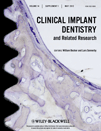An Experimental Comparison of Two Different Clinically Used Implant Designs and Surfaces
[Correction statement added after online publication 17 August 2012: author name Sargon Barkamo corrected to Sargon Barkarmo.]
ABSTRACT
Background: Various designs of dental implants representing different geometries and surface technologies are commercially available and clinically used in patients. However, data with regard to bone tissue responses and stability for comparison of their biologic performances are rare.
Purpose: The aim of the present experimental investigation was to compare the bone tissue responses and implant stability between two commonly used dental implants representing different geometries and surface characteristics.
Materials and Methods: A total of 90 dental implants (4.3 mm in diameter, 10 mm long) with an oxidized surface (Replace Select Tapered, TiUnite, Nobel Biocare AB, Gothenburg, Sweden) (OX) and 90 implants (4.1 mm in diameter, 10 mm total length) with a hydrophilic sand-blasted and acid etched surface (Standard Plus, SLActive, Institut Straumann AG, Basel, Switzerland) (HSBA) were placed in the distal femur (n = 1) and tibia (n = 2) of 30 rabbits. The implants were analyzed with implant stability quotient (ISQ) measurements, removal torque (RTQ) and histomorphometry (bone–implant contact, BIC) after 10 days, 3, and 6 weeks. Moreover, RTQ values were corrected for differences in surface area by calculating the shear strength for each implant.
Results: RTQ and ISQ measurements showed an increase with time for both implant types. A significantly higher RTQ value was observed for the HSBA implant at 3 weeks (p = .05). A lower ISQ value was seen for HSBA than for OX implants at placement in the tibia (p < 0.001). HSBA implants showed higher shear strength values than OX implants after 3 weeks (p < .001), and 6 weeks (p < .01). The morphometric measurements showed significantly higher BIC for HSBA implants after 10 days (p < .01), similar values after 3 weeks and significantly higher BIC for OX implants after 6 weeks (p < .001).
Conclusions: Both HSBA and OX implants were well integrated in bone and showed firm and increased stability from placement to after 6 weeks of healing. The HSBA implant showed more BIC after 10 days and the OX implant more BIC after 6 weeks of healing. The HSBA implant showed significantly higher shear strength after 3 and 6 weeks and higher RTQ values after 3 weeks than the OX implant. The results may be due to differences in surface roughness and hydrophilic properties.




